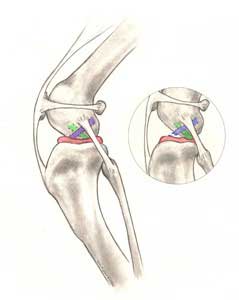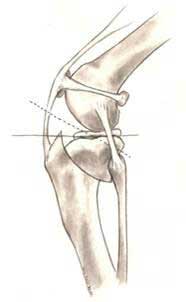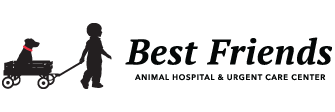Cranial Cruciate Ligament Injury and Repair

Overview/Terminology
Cruciate ligament injury is the most common stifle/knee injury we see at Best Friends Animal Hospital. The cranial cruciate ligament (or CCL, see Figure 1) is one of the most important stabilizers inside the knee (also called ‘stifle’) joint. In humans the CCL is called the anterior cruciate ligament (or ACL). The meniscus (see Figure 1) is a ‘cartilage-like’ structure that sits in between the thigh and shin bones and helps with shock absorption, sensory and load bearing and is frequently damaged when the CCL is injured. Complete or partial tears of the CCL is one of the most common reasons for hind limb lameness, pain and subsequent arthritis. In general, surgery in combination with joint supplements is recommended to slow down progression of arthritis and to eliminate/minimize lameness.
Fig 1: Illustration of the anatomy of the dog’s knee: Blue = cranial cruciate ligament; Red = meniscus; Green = caudal cruciate; the insert shows a ruptured cranial cruciate ligament.

Causes
In humans, trauma (such as skiing, soccer, and football injuries) is the most common reason for injury of the ACL/CCL. Traumatic rupture can happen in dogs but is rarer. Most commonly CCLD is caused by a combination of many factors, including aging of the ligament (degeneration), obesity, poor physical condition, conformation and breed. This difference between people and dogs explains two important features of canine CCLD:
- Partial tearing of the CCL is common in dogs and frequently progresses to a full tear over time.
- At least half of the dogs that have a cruciate ligament problem in one knee will likely, at some future time, develop a similar problem in the other knee.
Incidence and Prevalence
- Certain breeds are more commonly affected such as Labrador Retrievers, Golden Retrievers, Rottweilers, and Newfoundlands.
- Obesity can predispose dogs to injury of their CCL as well.
- Dogs spayed/neutered early (prior to 6 months of age) may have a higher prevalence.
- Cruciate disease affects dogs of all sizes and ages and rarely cats.
- Over 50% will go on to rupture the CCL in the other knee.
Signs and Symptoms
- Sporadic lameness (especially after activity)
- Sit Test: Dogs will often not sit “squarely,” but rather put their leg(s) out to the side when they sit down.
- Difficulty rising, trouble jumping into the car as well as a decreased activity level.
- Muscle atrophy (decreased muscle mass in the affected leg)
- Decreased range of motion, a popping noise (which may indicate a meniscal tear), and swelling on the inside of the shin bone are other symptoms.
- Shifting of weight away from the damaged leg when they stand but the lameness is less obvious during walking (especially with partial tears of the CCL).
- Complete ruptures usually result in non-weight bearing lameness.
Diagnosis
Diagnosing complete tears of the CCL is accomplished by a combination of observation of your pet’s gait, palpation of the knee, and radiographs (x-rays).
Complications Caused by the Condition
- Arthritis, loss of range of motion in the joint, muscle atrophy, and loss of full function of the limb, as well as decreased activity.
- Pain
* Unfortunately, neither human nor veterinary surgeons are able to completely restore normal joint anatomy and function. Even with surgery some progression of arthritis is expected. It is important to understand that arthritis is a non-reversible disease and hence everything should be done to prevent its development or progression.
Therefore, two steps are crucial when treating CCLD: surgical repair and medical management.
Treatment Options
There are many treatment options for CCLD but the first major decision is between surgical treatment and conservative treatment/management. The best option for your pet depends on many factors such as your pet’s activity level, size, age, and conformation, as well as the degree of knee instability. Finances must also be considered.
In general SURGICAL TREATMENT is recommended for CCLD since it is the only way to permanently control the instability in the stifle joint and to evaluate the structures within the joint. Two surgical options are offered at our hospital:
1. Tibial Plateau Leveling Osteotomy (TPLO)
- Best for active dogs, large dogs, or dogs with a certain degree of tibial slope.
- Method: Involves making a circular cut in the tibial plateau and rotating the contact surface of this bone until it attains a relatively level orientation that puts in at approximately 90 degrees to the attachment of the quadriceps muscles (see Figure 2). This orientation of the tibial plateau renders the knee relatively stable. The cut in the bone needs to be stabilized by the use of a bridging bone plate and screws (see Figure 3).
- Advantages: Very strong. Best for durability, longevity, and function.
- Complications: Infection, failure of implants.
Figure 2: Illustration of the concept of the TPLO procedure which involves making a circular cut in the tibial plateau and rotating the contact surface of this bone until it attains a relatively level orientation that puts it at approximately 90 degrees to the attachment of the quadriceps muscles.

Figure 3: Illustration of the TPLO procedure utilizing bone plates and screws. Image provided by Synthes (USA); copyright notice: 2012 Synthes, Inc. or its affiliates. All rights reserved.

2. Extra-capsular suture stabilization aka “Lat Fab”
- Best for smaller dogs.
- Method: Less invasive. A strong suture line is placed outside of the joint to add stability. The suture needs to stabilize the knee joint, while allowing normal knee movement, until organized scar tissue can form and assume the stabilizing role.
- Advantages: Less expensive than a TPLO, less invasive, can be repeated
- Complications: Failure of the suture and progressive development of arthritis. Suture failure tends to be more common in larger, active dogs; hence many surgeons reserve this technique for small breeds, older, and/or inactive dogs.
Post-Surgical Aftercare
- Postoperative care at home is very critical.
- Premature, uncontrolled or excessive activity risks complete or partial failure of the surgical repair which can be catastrophic.
- Proper post-operative care includes crate rest for several months, leash walks for bathroom breaks only; no running, jumping, rough-housing, or off leash activity for several months.
Non-Surgical Treatment usually involves a combination of medications, exercise, modification, joint supplements, and possibly braces/orthotics:
Activity restriction and anti-inflammatories. The lameness associated with CCLD usually waxes and wanes and generally improves significantly with the administration of pain medications (please note that dogs should not be given any Aspirin) and rest. Especially in small dogs and with partial tears the lameness may completely disappear with this treatment but usually some degree of lameness remains in larger dogs. Attempts to return to normal activity levels will often be limited by the progression of arthritis. The combination of pain medications and rest is not a treatment because it does not stabilize the knee. Therefore, this treatment is generally not advised, but may be appropriate for individual dogs due to some combination of their very small size, inactive lifestyle, other concurrent injuries or diseases, or financial realities.
Rehabilitation therapy. There is ample evidence that the rehabilitation therapy by a trained rehabilitation practitioner can advance and hasten the recovery from surgery. However, there is little evidence to suggest that this is a consistent and predictable alternative to surgical management for most dogs. Occasionally the combination of concurrent injuries or diseases, advanced age, patient size, and financial limitations may make this an attractive alternative option.
Prognosis
Long term prognosis for animals undergoing surgical repair of the CCLD is good, with clinical reports of improvement is 85-90% of the cases. It is important to realize that arthritis is a progressive disease and develops fairly quickly in an injured (or damaged) stifle joint. Hence, early surgical repair is advised by most surgeons.
Prevention
As mentioned previously obesity and poor physical condition are risk factors for the development of CCLD. If your dog is overweight, a weight loss program might be advisable. Regular, daily activity is another important component of CCLD prevention.
